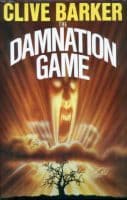 The Damnation Game is the first and still the finest of Mr. Barker’s literary accomplishments, arguably the pinnacle of the genre and certainly the progenitor of one of the most original literary collections ever penned. Since the 29th of every month is the sacred day of Hekate, its publication on August 29, 1984 was appropriate, perhaps an omen.
The Damnation Game is the first and still the finest of Mr. Barker’s literary accomplishments, arguably the pinnacle of the genre and certainly the progenitor of one of the most original literary collections ever penned. Since the 29th of every month is the sacred day of Hekate, its publication on August 29, 1984 was appropriate, perhaps an omen.
Those who follow the dark genres know that much of the current offerings are knockoffs of seminal themes created by trail blazers such as Lovecraft and Hawthorne, the great romancer. How many times can the “Monkey’s Paw” be bastardized? Thankfully, true puritans have Clive Barker, a writer who will take their hand and lead us down paths we have never before traveled. In addition, his Mastery of the language raises his mesmerizing tales to truly literary levels.
The first chapter of The Damnation Game alone is worth the price of the novel and will permanently imprint itself upon a reader’s mind. Barker’s ability to marry the real and the imaginary lures readers into a grotesque version of post-war Poland—Terra Incognita. The visions are so compelling that readers not only willingly suspend their disbelief, they lean into the text and beg for more. The setting and characters are so clearly defined, so palpable that readers will be unable to turn away. The first few sentences at first seem a reasonable depiction of post-war Warsaw. One evocative sentence warns readers that this is not quite reality? “Mountains of rubble—still nurturing the dead like bulbs ready to sprout as the spring weather warmed—clogged the streets. Soon, Barker stuns readers when he depicts a cup-and-ball game with a baby’s head as the ball.
The first character, known only as The Thief, wanders through the rubble of Warsaw, searching for Mamoulian, a gambler who never loses. The Thief is “in love” with the prospect of testing his skills against the famed gambler even though he has been warned that others who had dared to play with Mamouilan had been dealt with harshly. Out of the desolation and devastation of Warsaw, appears a highly symbolic, magnificent tree in full bloom. It anoints the gambler with a rain of white, sweet-smelling petals. Readers know he will soon meet the gambler. A woman whose lips have been sliced off leads The Thief to Mamoulian who renames The Thief as “Pilgrim,” thus tying the flowering tree and the Pilgrim together in a nod to Dante’s Pilgrim’s Progress. Hypnotized by Mamoulian’s skill with cards, The Thief yields to temptation and sits to play.
In part two, readers wake in a modern era, no doubt longing for the haunting visions of part one. A new thief, a prisoner, Marty Strauss, is offered a vague job opportunity by a Mr. Toy. Toy’s employer, Mr. Whitehead, need a personal bodyguard. Why? An adept reader will certainly connect Whithead’s name with the magical tree of white blossoms.
Strauss is chosen for the position. With an early release from prison, he, a new pilgrim, enters the lair of the mysterious Mr. Whitehead. Strauss has entered a strange world that is almost as bizarre as the previous version of Warsaw in which the original Puritan wandered. The story that unfolds is complex, dark, and twisted, but somehow wholly believable as in magical realism.
Among a cast of delicious characters, the standout is Anthony Breer, the Razor-Eater, member of the tribe of Razor-Eaters. The Last European enhances the mystery of the story. Readers will agonize over who he is. Whitehead’s daughter adds a touch of romance. The POV slips seamlessly from one character to another.
The mystery, danger, and gore climb as the characters and all plot lines come together for a magnificent revenge debacle. But, it does not end there . . .
It could be said that the most stunning aspect of this novel is Mr. Barker’s ability to manipulate the English language. Linquaphiles will find themselves rereading sentences, enthralled by their sheer beauty, by their ability to say so much so economically. There are no gratuitous info dumps. Every sentence propels the plot fluidly, precisely, and meaningfully.
Readers who appreciate Barker’s prose should take time to view his brilliant works of art. They are as unique and marvelous as are his novels.
Clive Barker on The Damnation Game
the first and still the finest of Mr. Barker's literary accomplishments, arguably the pinnacle of the genre and certainly the progenitor of one of the most original literary collections ever penned.

Book Title: The Damnation Game
Book Author: Clive Barker
Book Format: Hardcover
Logo:
